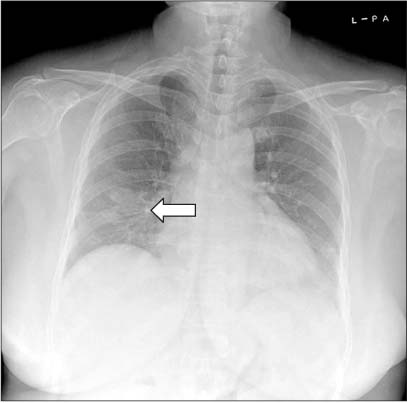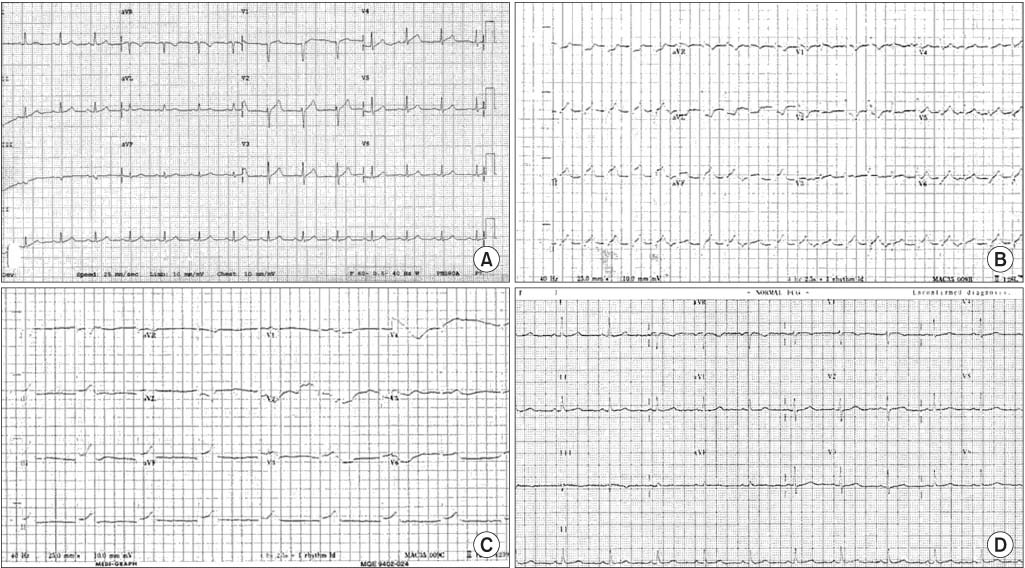Ewha Med J.
2014 Dec;37(Suppl):S28-S32. 10.12771/emj.2014.37.S.S28.
Anesthetic Management for Lung Adenocarcinoma Experienced Acute Neurocardiogenic Syncope and Cardiac Arrest
- Affiliations
-
- 1Department of Anesthesiology and Pain Medicine, Ewha Womans University School of Medicine, Seoul, Korea. ankyj@ewha.ac.kr
- KMID: 2171308
- DOI: http://doi.org/10.12771/emj.2014.37.S.S28
Abstract
- Vasovagal syncope is one of the most common causes of transient syncope during anesthesia for elective surgery in patients with a history of syncope and requires special attention and management of anesthetics. The causes and pathophysiological mechanism of this condition are poorly understood, but it has a benign clinical course and recovers spontaneously. However, in some cases, this condition may cause cardiovascular collapse resulting in major ischemic organ injury and be life threatening. Herein we report a case and review literature, regarding completing anesthesia safely during an elective surgery of a 59-year-old female patient with history of loss of consciousness due to suspected vasovagal syncope followed by cardiovascular collapse and cardiac arrest, which required cardiopulmonary resuscitation and insertion of a temporary pacemaker and intra-aortic balloon pump immediately after a fine-needle aspiration biopsy of a lung nodule located in the right middle lobe.
Keyword
MeSH Terms
Figure
Reference
-
1. Soteriades ES, Evans JC, Larson MG, Chen MH, Chen L, Benjamin EJ, et al. Incidence and prognosis of syncope. N Engl J Med. 2002; 347:878–885.2. White CM, Tsikouris JP. A review of pathophysiology and therapy of patients with vasovagal syncope. Pharmacotherapy. 2000; 20:158–165.3. Chen-Scarabelli C, Scarabelli TM. Neurocardiogenic syncope. BMJ. 2004; 329:336–341.4. Kinsella SM, Tuckey JP. Perioperative bradycardia and asystole: relationship to vasovagal syncope and the Bezold-Jarisch reflex. Br J Anaesth. 2001; 86:859–868.5. Jang YE, Do SH, Song IA. Vasovagal cardiac arrest during spinal anesthesia for Cesarean section: a case report. Korean J Anesthesiol. 2013; 64:77–81.6. Park SY, Kim SS. An anesthetic experience with cesarean section in a patient with vasovagal syncope: a case report. Korean J Anesthesiol. 2010; 59:130–134.7. Tsai PS, Chen CP, Tsai MS. Perioperative vasovagal syncope with focus on obstetric anesthesia. Taiwan J Obstet Gynecol. 2006; 45:208–214.8. Shimizu K, Yoshii Y, Watanabe S, Hosoda C, Takagi M, Tominaga T, et al. Neurally mediated syncope associated with small cell lung cancer: a case report and review. Intern Med. 2011; 50:2367–2369.9. Angelini P, Holoye PY. Neurocardiogenic syncope and Prinzmetal's angina associated with bronchogenic carcinoma. Chest. 1997; 111:819–822.10. Koga T, Kaseda S, Miyazaki N, Kawazoe N, Abe I, Sadoshima S, et al. Neurally mediated syncope induced by lung cancer--a case report. Angiology. 2000; 51:263–267.11. Gracie J, Baker C, Freeston MH, Newton JL. The role of psychological factors in the aetiology and treatment of vasovagal syncope. Indian Pacing Electrophysiol J. 2004; 4:79–84.12. Grubb BP. Neurocardiogenic syncope and related disorders of orthostatic intolerance. Circulation. 2005; 111:2997–3006.13. Parry SW, Matthews IG. Update on the role of pacemaker therapy in vasovagal syncope and carotid sinus syndrome. Prog Cardiovasc Dis. 2013; 55:434–442.
- Full Text Links
- Actions
-
Cited
- CITED
-
- Close
- Share
- Similar articles
-
- A Sudden Cardiac Arrest during Spinal Anesthesia
- Usefulness of tilt training in patients with neurocardiogenic syncope
- Comparison of Recurrence Rate Based on the Frequency of Preceding Symptoms in Patients With Neurocardiogenic Syncope or Presyncope
- One-Lung Anesthetic Management of a Patient with Brugada Syndrome: A case report
- Cardiac Arrest under Anesthesia in a Child with Previously Undiagnosed Long QT Syndrome: A case report



